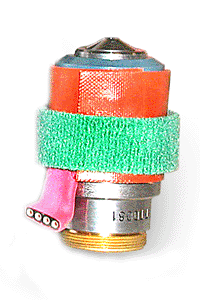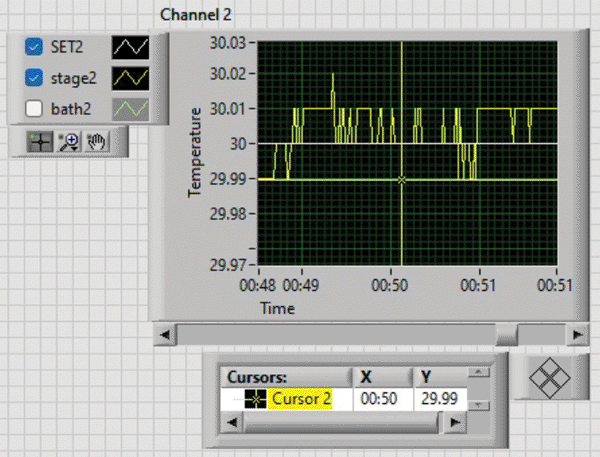|
|
| |
|

Objective Heater - Warmer Upgrade
A thin flexible polyimide heater for any microscope objective.
Used with oil or water immersion optics. Built-in temperature sensor. Easy to attach and remove. Simply wrap
the heater around objective and secure with included Velcro tape.
The heater is usually attached to a cylindrical surface of the
objective, closer to the sample.
The controller stores two settings in its memory for different size objectives.
Sample publications.
Specifications: |
Dimensions: | 0.5/0.25in. wide x
5/10in long
(around objective surface) |
Temperature stability: | 0.01°C,
self-adjusting, required for sensitive applications: nano/piezo
positioning or confocal imaging |
Dual overheating protection: | regulated power output down to 0W;
settings eliminate temperature overshoot;
adjustable temperature threshold |
Easy to install: | Fits any objective |
Click on catalog numbers below to purchase online.
Required accessories: temperature controllers.
Download PDF manual.
Download PDF catalog.
The picture below demonstrates high temperature stability provided by the heater. This is a temperature recording from TC-HLS objective heater.
Most of the data points are between 0.01°C deviation from 30°C set level. The cursor is placed at 29.99°C level. The data points were obtained every second.

|
|
Bioscience Tools
ph: 877-853-9755,
fax: 866-533-7490
email: info@biosciencetools.com
|
PRICES AND OPTIONS |
TC-HLS-05 |
$495 |
Objective Heater Upgrade, 0.5x5in.
|
TC-HLS-025 |
$495 |
Objective/Syringe Heater Upgrade, 0.25x10in.
|
MTC-HLS-025 |
$1,490 |
Temperature controller TC-1-100S with Objective Heater,
0.5x5in, connecting cable and power supply.
|
Sample publications:
42
Out-of-focus signal rejection for in vivo pO2 measurements using two-photon phosphorescence lifetime microscopy: supplement.
Biomedical Optics Express (supplemental document), 12 December 2024;
41
Validity of Single Fluorescent Molecule to Report Local Dynamics of a Polymer Matrix: The Effect of Molecular Architecture.
Macro- Molecular Chemistry and Physics, Volume 224, Issue 21 November 2023;
40
Measurements of cerebral microvascular blood flow, oxygenation, and morphology in a mouse model of whole-brain irradiation-induced cognitive impairment by two-photon microscopy and optical coherence tomography: evidence for microvascular injury in the cerebral white matter.
GeroScience, Volume 45, pages 1491–1510, (2023);
39
Aerobic exercise reverses aging-induced depth-dependent decline in cerebral microcirculation.
eLife, July 25, 2023;
38
Stress accumulation by confined ice in a temperature gradient.
PNAS, July 29, 2022;
37
Adhesive Tape Microfluidics with an Autofocusing Module That Incorporates CRISPR Interference: Applications to Long-Term Bacterial Antibiotic Studies.
ACS Sens. 2019, 4, 2638−2645;
36
Controlling Kinetic Pathways in Demixing Microgel-Micelle Mixtures.
Langmuir, 39(3), 2023;
35
Optical measurement of microvascular oxygenation and blood flow responses in awake mouse cortex during functional activation.
SAGE Jornal, 2022;
34
Addressing challenges in the removal of unbound dye from passively labelled extracellular vesicles.
Nanoscale Adv., 2022, 4, 226-240;
33
Programming Directed Motion with DNAGrafted Particles.
ACS Nano 2022, 16, 9195−9202;
32
Baseline oxygen consumption decreases with cortical depth.
PLOS Biology, October 27, 2022;
31
Two-photon microscopic imaging of capillary red blood cell flux in mouse brain reveals vulnerability of cerebral white matter to hypoperfusion.
Journal of Cerebral Blood Flow & Metabolism 2019;
30
Dynamic Transition States of ErbB1 Phosphorylation Predicted by Spatial Stochastic Modeling.
Biophysical Journal 105(6) 1533–1543 2013;
29
The role of diffusion and membrane topography in the initiation of high affinity IgE receptor signaling.
5-1-2011;
28
Microscopic Quantification of Oxygen Consumption across Cortical Layers.
bioRxiv - Neuroscience, October 14 2021;
27
Size homeostasis in adherent cells studied by synthetic phase microscopy.
PNAS September 24, 2013;
26
Controlling phase separation in microgel-polymeric micelle mixtures using variable quench rates.
arXiv:2104.04022v1 8 Apr 2021;
25
Addressing challenges in the removal of unbound dye from passively labelled extracellular vesicles.
Nanoscale Adv., 2022, 4, 226-240;
24
Direct observation of individual tubulin dimers binding to growing microtubules
eLife 2019; 8;
23
More homogeneous capillary flow and oxygenation in deeper cortical layers correlate with increased oxygen extraction
eLife 2019; 8;
22
Spatial Temporal Analysis of Fieldwise Flow in Microvasculature
J. Vis. Exp. (153), (2019);
21
FLIM reveals alternative EV-mediated cellular up-take pathways of paclitaxel
Journal of Controlled Release 2018, 284, 133-143;
20
Imaging and Spectroscopic Analysis of Living Cells
Methods in Enzymology, 2012;
19
Direct observation of individual tubulin dimers binding to growing microtubules
bioRxiv, Sep. 14, 2018;
18
Fluorescence Lifetime Microscopy of Tumor Cell Invasion, Drug Delivery, and Cytotoxicity.
Methods in Enzymology Volume 504, 2012, Pages 109-125;
17
Using DNA strand displacement to control interactions in DNA-grafted colloids.
Soft Matter, 2018, 14, 969;
16
Detection of Site-dependent Segmental Mobility of Polymer.
Journal of Polymer Science, 2017, 35(12): 1488-1496;
15
Examining dynamics in a polymer matrix by single molecule fluorescence probes of different sizes.
Soft Matter, 2016,12, 7299-7306;
14
MICROSTRUCTURE AND PHASE BEHAVIOR IN COLLOIDS AND LIQUID CRYSTALS.
University of Pennsylvania;
13
COMPOUNDS THAT BIND DYSTROGLYCAN AND USES THEREOF.
United States Patent Application 20150374845;
12
Effects of cytoskeletal disruption on transport, structure, and rheology within mammalian cells.
PHYSICS OF FLUIDS 19, 103102 2007;
11
Scanning Electrochemical Microscopy of Individual Pancreatic Islets.
Journal of The Electrochemical Society, 163 (4) H3077-H3082 (2016);
10.
Elastic Instability of a Crystal Growing on a Curved Surface.
7 February 2014, Science 343, 634 (2014);
9
Endocytic trafficking of laminin is controlled by dystroglycan and is disrupted in cancers.
November 15, 2014 J Cell Sci 127, 4894-4903;
8
Investigating G protein-coupled receptor endocytosis and trafficking by TIR-FM.
Methods Mol Biol. 2011; 756: 325–332;
7,
6,
5,
4,
3,
1,
2.
|
|